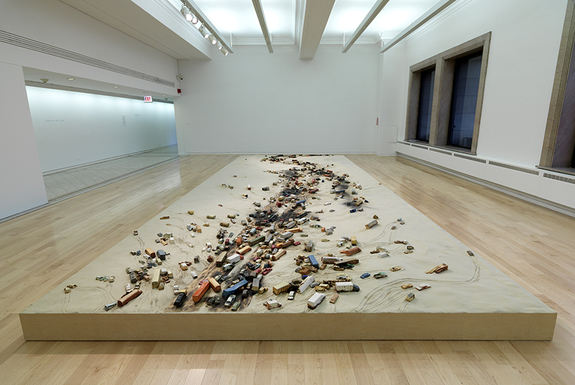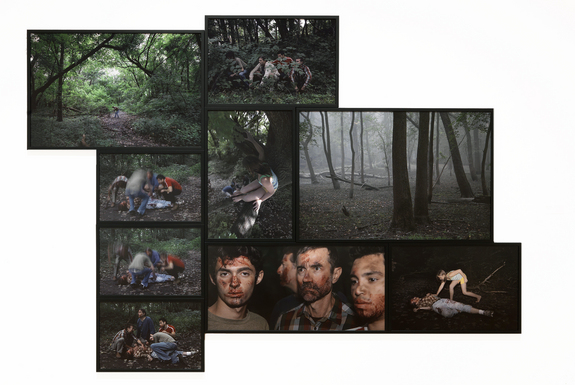
Installation view of Alison Ruttan’s “Line in the Sand” at the Chicago Cultural Center.
Image via Alison Ruttan.
Alison Ruttan: if all you have is a hammer, everything looks like a nail
Runs through April 26, 2015
Chicago Cultural Center, Michigan Ave. galleries
78 E. Washington St., Chicago, IL
Alison Ruttan’s work is about genetic destiny. Inside the three Michigan Avenue galleries of the Chicago Cultural Center, we see how human nature plays havoc with communities through two parallel series: one, a series of photographs and a video depict humans reenacting narratives from Jane Goodall’s studies of chimps; two, a series of sculptures that depict the wreckage of the 2006 Lebanon war and a desert path filled with deserted cars and trucks.
At the crux of Ruttan’s message is the question of whether we are genetically programmed towards violence, just like our primate cousins. Take, for example, “The Four Year War at Gombe,” a photographic and video series so different in style from Ruttan’s sculptural works, their placement feels visually jarring. The cinematic photographs show Ruttan’s family and friends reenacting Jane Goodall’s observations about a peaceful community of primates that splintered and lived as neighbors before eventually beginning to murder one another.

Detail of Alison Ruttan’s “The Four Year War at Gombe” at the Chicago Cultural Center. Image via Alison Ruttan.
Conceptually, the gestures appear to make the point that, indeed, there is no fighting our nature. But a look at the photographs themselves reveals some hope, albeit implied. It’s obvious these people are not chimps. They’re in their street clothes, and human-chimps kiss, groom, roll in the grass and swing from branches. There is sameness implied in the narrative that runs from peace to war times, but visually, the difference between human and animals is obvious. We do not have to share their path.
While the chimp series leads us to a rather straightforward conclusion about the nature of brutality, it plays a crucial role in construction the context of the overall exhibition. Ruttan’s crumbling miniature buildings in “a bad idea seems good again” depict Israel’s bombing of Lebanon, and similarly (though more obliquely) parallels the narrative of Goodall’s study. These Canaanite neighbors remain in violent discordance with each other.
But Ruttan’s view isn’t about the specific politics that lead to any one war in particular: what we see is the physical, human toll that all wars take. A multi-floor department store sheds pieces of its walls; a garage barely stands beneath the wreckage on its upper levels. Given a God’s eye perspective, viewers are able to literally behold the subject matter of war from above, surveying the charred, annihilated scenes in their vastness and totality. Their diminutive size translates the overwhelming scale of war into a consumable, gallery-size experience.
The same strategy is used in “Line in the Sand,” which features 500 tiny ceramic vehicles scattered across a scorched, sand-covered plinth—a recreation of the U.S. and Canadian forces’ attack on Iraqi military and civilians as they retreated on Highway 80 between Iraq and Kuwait during the Gulf War. Here, the sculptures sit inert, as if they were destined to be there in the first place.
All of this leads a viewer to ask the question: are we slaves to our genetics and social history? As much as Ruttan’s work suggests that our biological inclinations might make the hope for peaceful existence futile, within it, too, is a subtle optimism. While we very much resemble our primate cousins, the fact remains that we are not them, and within us lies the possibility to counter the violence in our genetic disposition.


Comments on this entry are closed.